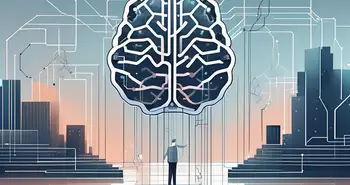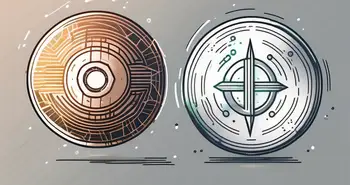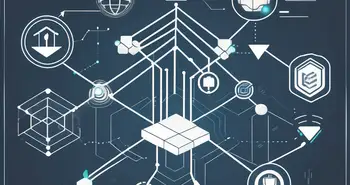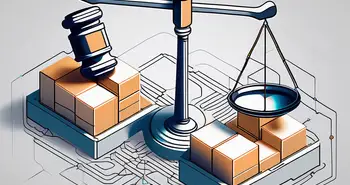Open Banking vs. Blockchain: Understanding Their Differences and Complementary Potential

Open banking and blockchain are two revolutionary technologies that have the potential to transform the way we conduct financial transactions. While they serve different purposes, open banking and blockchain are not mutually exclusive. In fact, they have complementary potential that can revolutionize the financial industry. In this article, I will explain the differences between open banking and blockchain, explore their unique features and benefits, and discuss how they can work together to shape the future of finance.
Defining Open Banking
Open banking is a concept that refers to the practice of sharing financial data between different parties through the use of application programming interfaces (APIs). It enables third-party developers to build applications and services around banks' data, making it easier for consumers to manage their finances.
The Evolution of Open Banking
Open banking has evolved over time, driven by technological advancements and changing consumer expectations. Previously, banks held a monopoly over financial data, limiting access to third-party providers. However, with the advent of APIs, banks have opened up their data, allowing consumers to securely share their financial information with trusted third parties.
This evolution has been a game-changer in the financial industry. It has transformed the way consumers interact with their finances, providing them with more control and flexibility. No longer confined to the traditional banking experience, consumers now have access to a wide range of innovative financial products and services.
Key Features of Open Banking
Open banking brings numerous features that empower consumers and foster innovation in the financial sector. Firstly, it provides consumers with greater control over their financial data, enabling them to securely share it with authorized third parties. This control allows consumers to make more informed decisions about their finances and take advantage of personalized financial services tailored to their specific needs.
Furthermore, open banking encourages competition and drives innovation by allowing third-party providers to create innovative financial products and services. This competition benefits consumers by offering them a wider range of options and better pricing. It also encourages banks to continuously improve their offerings to stay competitive in the market.
Benefits and Challenges of Open Banking
The benefits of open banking are manifold. Consumers can enjoy personalized financial services tailored to their specific needs, as well as access to a wider range of products and providers. This increased competition leads to better pricing and improved customer service.
Additionally, open banking enhances transparency and fosters trust between consumers and financial institutions. With the ability to securely share their financial data, consumers can have a clearer understanding of their financial situation and make more informed decisions. This transparency also holds banks accountable for their actions and encourages them to prioritize customer satisfaction.
However, open banking also presents challenges. Data privacy and security are paramount concerns, as consumers need to trust that their financial information is being safeguarded against unauthorized access. Financial institutions must invest in robust security measures and adhere to strict data protection regulations to ensure the safety of consumer data.
Moreover, standardizing APIs across different banks can pose technical challenges in implementing open banking initiatives. Each bank may have its own unique systems and infrastructure, making it difficult to establish a unified framework for data sharing. Collaboration and cooperation between banks, regulators, and technology providers are crucial in overcoming these challenges and ensuring the smooth implementation of open banking.
Understanding Blockchain Technology
Blockchain is a decentralized digital ledger that records transactions across multiple computers in a secure and transparent manner. Unlike traditional banking systems that rely on intermediaries, blockchain technology enables peer-to-peer transactions without the need for third-party involvement.
The Concept of Blockchain Explained
At its core, blockchain is a distributed ledger that stores information in blocks linked together in a chain. Each block contains a collection of transactions, and each transaction is verified, recorded, and stored across multiple computers, creating an immutable record.
Imagine a giant, virtual book that everyone can access and contribute to. Each page of this book represents a block, and every time a new transaction occurs, it is added as a new page to the book. However, unlike a physical book, this virtual book is duplicated and stored on multiple computers, known as nodes, spread across the world. This duplication ensures that even if one node fails or is compromised, the information is still preserved on other nodes, making it highly secure and resistant to tampering.
How Blockchain Works
Blockchain operates through a consensus mechanism, which ensures that all participants agree on the validity of transactions. This consensus is achieved through complex algorithms, such as proof-of-work or proof-of-stake, which require participants to solve cryptographic puzzles or hold a certain amount of cryptocurrency.
Let's take a closer look at the proof-of-work algorithm. In this process, participants, known as miners, compete to solve a mathematical puzzle. The first miner to solve the puzzle gets to add the next block of transactions to the chain and is rewarded with a certain amount of cryptocurrency. This competition not only secures the network but also incentivizes miners to invest in powerful hardware and consume significant amounts of energy.
Advantages and Limitations of Blockchain
Blockchain offers several advantages over traditional banking systems. It eliminates the need for intermediaries, reduces costs, and increases the speed of transactions. Furthermore, blockchain ensures transparency and immutability, as any changes made to the ledger require consensus from the network.
Imagine a world where you can send money to anyone, anywhere, at any time, without having to go through banks or payment processors. Blockchain makes this possible by enabling direct peer-to-peer transactions, cutting out the middlemen and reducing fees. Additionally, the decentralized nature of blockchain ensures that no single entity has control over the network, making it resistant to censorship and corruption.
However, blockchain also has its limitations. Scalability remains a challenge, as the technology struggles to handle a large volume of transactions. Currently, popular blockchain networks like Bitcoin and Ethereum can process only a limited number of transactions per second, which pales in comparison to traditional payment systems like Visa, which can handle thousands of transactions per second.
Furthermore, the energy consumption required for mining cryptocurrencies has raised concerns about the environmental impact of blockchain networks. The computational power needed to solve the complex puzzles and secure the network consumes a significant amount of electricity, leading to carbon emissions and contributing to climate change. Efforts are being made to develop more energy-efficient consensus mechanisms, but this remains an ongoing challenge for the blockchain industry.
Comparing Open Banking and Blockchain
While open banking and blockchain serve different purposes, they share some similarities. Both technologies aim to increase transparency and empower consumers in the financial sector. However, there are distinct differences in their functions.
Similarities Between Open Banking and Blockchain
Both open banking and blockchain put control of financial data in the hands of consumers. They enable individuals to securely share their information with trusted parties, fostering transparency and trust. Additionally, both technologies promote innovation in the financial sector, providing consumers with more choices and personalized services.
Distinct Differences in Their Functions
While open banking focuses on data sharing and access to financial services, blockchain primarily addresses the decentralized and secure nature of transactions. Open banking relies on APIs and partnerships between banks and third-party providers, whereas blockchain removes the need for intermediaries altogether through its decentralized infrastructure.
The Complementary Potential of Open Banking and Blockchain
Open banking and blockchain have the potential to complement each other and create new opportunities in the financial industry.
How Open Banking Can Benefit from Blockchain
Blockchain technology can enhance the security and privacy aspects of open banking. By using blockchain to store and verify financial data, the risk of data breaches and unauthorized access can be significantly reduced. Additionally, blockchain can streamline the authentication and consent processes, making it easier for consumers to share their data with authorized third parties.
Potential Challenges in Integrating Blockchain with Open Banking
Integrating blockchain with open banking is not without challenges. Technical hurdles, such as scalability and interoperability, need to be overcome to ensure seamless integration. Moreover, regulatory frameworks must be developed to address the unique features of blockchain technology and its implications for open banking.
The Future of Open Banking and Blockchain
The future of open banking and blockchain looks promising, with numerous advancements and opportunities on the horizon.
Predicted Trends in Open Banking and Blockchain
As technology continues to evolve, we can expect to see increased collaboration between banks and fintech companies in the open banking space. Artificial intelligence and machine learning will play a crucial role in personalizing financial services for consumers. Additionally, blockchain will continue to be adopted in various industries beyond finance, revolutionizing supply chain management, healthcare, and more.
The Role of Regulations in Shaping Their Future
Regulatory frameworks will play a crucial role in defining the future of open banking and blockchain. Governments and regulatory bodies need to strike a balance between fostering innovation and ensuring consumer protection. Clear guidelines and standards are necessary to address the unique challenges and opportunities presented by open banking and blockchain technology.
In conclusion, open banking and blockchain are two technologies that have the power to transform the financial industry. While they serve different purposes, their complementary potential is undeniable. By harnessing the benefits of open banking and blockchain, we can create a more inclusive, transparent, and secure financial ecosystem. Embracing these technologies will pave the way for a future where consumers have greater control over their finances and enjoy innovative financial services tailored to their individual needs.
What is open banking and how does it work?
Open banking is the practice of sharing financial data between banks and authorized third parties through APIs. It enables consumers to securely share their financial information, giving them more control and choice over their finances.
What is blockchain and what are its advantages?
Blockchain is a decentralized digital ledger that records transactions across multiple computers. Its advantages include increased security, transparency, and efficiency, as well as the elimination of intermediaries.
How do open banking and blockchain complement each other?
Open banking can benefit from blockchain by enhancing security and privacy, while blockchain can streamline processes and improve trust in open banking. Together, they can create a more secure, transparent, and innovative financial ecosystem.
What are the challenges of implementing open banking and blockchain?
Some challenges of implementing open banking include ensuring data privacy and security, as well as standardizing APIs across different banks. For blockchain, scalability and interoperability continue to be obstacles, alongside concerns about energy consumption.
What does the future hold for open banking and blockchain?
We can expect increased collaboration between banks and fintech companies in open banking, with advancements in AI and machine learning. Blockchain will continue to expand beyond finance, transforming various industries. The role of regulations will be crucial in shaping their future.
As we embrace the future of finance shaped by open banking and blockchain, seize the opportunity to revolutionize your trading experience with Morpher. Our platform is at the forefront of leveraging blockchain's transformative power, offering zero fees, infinite liquidity, and the freedom to trade across various asset classes. With Morpher, you gain access to fractional investing, short selling without interest fees, and up to 10x leverage to amplify your trades. Experience the security and control of a non-custodial Morpher Wallet and explore the unique trading possibilities of Virtual Futures. Sign Up and Get Your Free Sign Up Bonus today, and join the vanguard of investors who are reshaping the world of investing with Morpher.

Disclaimer: All investments involve risk, and the past performance of a security, industry, sector, market, financial product, trading strategy, or individual’s trading does not guarantee future results or returns. Investors are fully responsible for any investment decisions they make. Such decisions should be based solely on an evaluation of their financial circumstances, investment objectives, risk tolerance, and liquidity needs. This post does not constitute investment advice.

Painless trading for everyone
Hundreds of markets all in one place - Apple, Bitcoin, Gold, Watches, NFTs, Sneakers and so much more.

Painless trading for everyone
Hundreds of markets all in one place - Apple, Bitcoin, Gold, Watches, NFTs, Sneakers and so much more.









